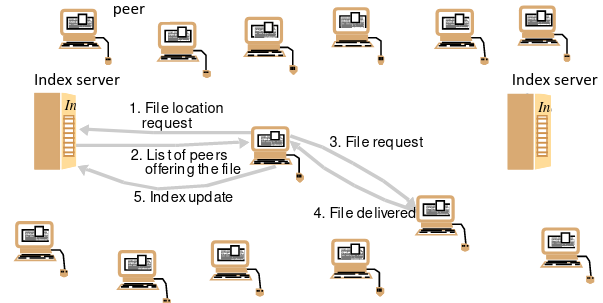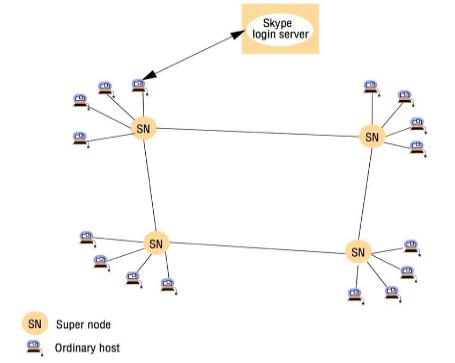12. Overlay Networks and Peer-to-Peer
21/03/23
Overlay Networks
- The internet = generic universal communication service
- Overlay network = virtual network
- On top of an existing network
- Multiple overlay networks can exist on an existing network
Types of overlay network
- Tailored to a specific application or service
- Distributed hash tables
- Peer-to-peer file sharing
- Content distribution networks
- Tailored for challenging network environments
- Wireless ad hoc networks
- Delay/disruption tolerant networks
- Offering additional network features
- (Wide area) Multicast, e.g. MBone
- Resilience
- Security, e.g. VPNs, TOR
Overlay routing vs IP routing
| IP | Overlay Network |
|---|---|
| Includes every node | Includes specific nodes/processes |
| Uses IP addresses | Defines own addresses |
| Fixed address assignment to nodes | Addresses may be assigned to objects/data |
| No replication | Often replicated |
| Stable network topology | Often volatile network |
| Fixed (next hop) routing | Overlay-defined routing |
| Simple local join (DHCP,etc) | Overlay network specific join |
| Must trust whole network | Need not trust whole network |
| No anonymity for address owners | Can have anonymity for address owners |
Overlay networks and p2p
Overlay network is effectively another communication paradigm
- P2P system can be seen as
- Set of (equivalent) process
- Communicating via a dedicated application-specific overlay network
- The overlay network provides the communication services needed by the p2p application
Peer-to-Peer
- Client-server approach - The server(s) are owned and managed by single service provider
- P2P aims to be completely decentralised
Application
- File sharing
- Teleconferencing
- Multiplayer (LAN) gaming
- P2P middlewear
Characteristics of P2P systems
- Each user(node) contributes resources
- All nodes have the same functional capabilities and responsibilities
- Correct operation does not depend on any centrally administered system
Typical P2P Goals
- Global scalability
- Load balancing
- Optimisation for local interactions between neighbouring peers
- Accommodating to highly dynamic host availability
- Security of data in an environment with heterogeneous trust
- Anonymity, deniability and resistance to censorship
Overlay networks and P2P
- A p2p system can be seen as
- Set of equivalent processes
- Communicating via a dedicated application-specific overlay network
P2P Examples
- Napster - Centralised indexes of P2P music sharing

- Gnutella - 2nd gen P2P file sharing. Two tier systems where some nodes are elected ultrapeers.
- Ultrapeers - form the core network. Global IP, highly inter-connected
- Leaf - connecting to ultrapeers

- Skype - Hybrid system, centralised servers for log-in/payment
- Supernodes - Dynamically selected ordinary hosts with suitable network access
- Ordinary Hosts - After initial login are directed to a super node

- Distributed hash tables (DHT) - Network maintains a set of values (files). Each value associated with a unique key (GUID)
- Peers can add/remove/get
P2P Middleware - Pastry
- Provides a flexible P2P facility on which applications can be built
- Add/remove resources
- Route requests to resources
- Join/leave overlay network
- Distributed hash table
- Distributed object location and routing